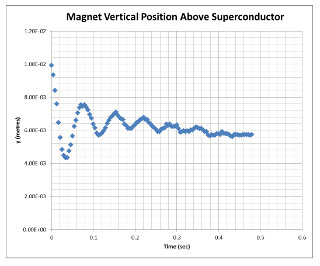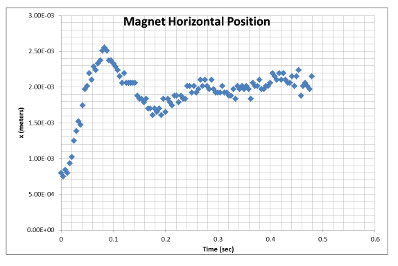Abstract
 Levitating a magnet above a superconductor is a very common demonstration. But if the magnet is dropped onto the superconductor it undergoes damped oscillations in the vertical and horizontal direction with different frequencies. We provide high speed video of the oscillations and position data.
Levitating a magnet above a superconductor is a very common demonstration. But if the magnet is dropped onto the superconductor it undergoes damped oscillations in the vertical and horizontal direction with different frequencies. We provide high speed video of the oscillations and position data.
Portable
Yes
Principles Illustrated
Look at Eddy Current Drag as an introduction to the physics illustrated by this experiment.
The falling magnet generates eddy currents in the superconductor that act as an electromagnet repelling the magnet and slowing its fall.
This seems impossible at first if we consider a material with finite resistance, although a version of the effect occurs with cooled copper as well. The magnet ‘bounces off the field’ a few centimetres above the superconductor. Bouncing means the falling magnet slows, stops, and then moves upwards. We can understand the slowing and the stopping: the repulsion force on the magnet is larger than its weight. But, according to Faraday’s law, the moment the magnet stops, the induced voltage disappears, the current stops, and there is no magnetic interaction. But remember, the superconductor has zero resistance and thus the induced current continues to flow. So the magnet rises, and begins oscillating.
Video
Download video (right-click and “save link as”, 27 MB): Superconbounce.m4v
Data
Analysis of the Motion
The motion was tracked using Tracker software (which we highly recommend) with the centre of mass of the magnet determined just by eye.
Contact us if you would like a higher resolution version of the high speed video or the original data.
NCEA & Science Curriculum
PHYS 2.4, PHYS 2.6, PHYS 3.6, University Physics
Instructions
As the small magnet levitates above the superconductor, gently tap it downward or sideways with plastic forceps.
Safety
Use standard liquid nitrogen safety precautions. If you are not trained to use liquid nitrogen and comfortable with it, contact a university physics or chemistry department for help.
Remember, rare Earth magnets are very toxic. Small ones particularly can be swallowed by children. Keep careful track of your magnet.
Individual teachers are responsible for safety in their own classes. Even familiar demonstrations should be practised and safety-checked by individual teachers before they are used in a classroom.
Related Resources
We have lots of eddy current resources. See Eddy Current Drag, Eddy Current Tank, and Bouncing Magnet in particular.
Teaching Resources
Would you like to contribute lesson suggestions? Contact us.
Credits
This demonstration resource was developed by a senior high school student under the direction of Victoria University academics.
This teaching resource was developed with support from
The MacDiarmid Institute
Faculty of Science, Victoria University of Wellington
School of Chemical and Physical Sciences, Victoria University of Wellington

